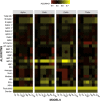Machine learning models effectively distinguish attention-deficit/hyperactivity disorder using event-related potentials
- PMID: 36408064
- PMCID: PMC9666608
- DOI: 10.1007/s11571-021-09746-2
Machine learning models effectively distinguish attention-deficit/hyperactivity disorder using event-related potentials
Abstract
Accurate diagnosis of Attention-Deficit/Hyperactivity Disorder (ADHD) is a significant challenge. Misdiagnosis has significant negative medical side effects. Due to the complex nature of this disorder, there is no computational expert system for diagnosis. Recently, automatic diagnosis of ADHD by machine learning analysis of brain signals has received an increased attention. This paper aimed to achieve an accurate model to discriminate between ADHD patients and healthy controls by pattern discovery. Event-Related Potentials (ERP) data were collected from ADHD patients and healthy controls. After pre-processing, ERP signals were decomposed and features were calculated for different frequency bands. The classification was carried out based on each feature using seven machine learning algorithms. Important features were then selected and combined. To find specific patterns for each model, the classification was repeated using the proposed patterns. Results indicated that the combination of complementary features can significantly improve the performance of the predictive models. The newly developed features, defined based on band power, were able to provide the best classification using the Generalized Linear Model, Logistic Regression, and Deep Learning with the average accuracy and Receiver operating characteristic curve > %99.85 and > 0.999, respectively. High and low frequencies (Beta, Delta) performed better than the mid, frequencies in the discrimination of ADHD from control. Altogether, this study developed a machine learning expert system that minimises misdiagnosis of ADHD and is beneficial for the evaluation of treatment efficacy.
Keywords: Attention deficit hyperactivity disorder; Band power; Classification; Event-related potentials; Frequency bands; Machine learning.
© The Author(s) 2022.
Figures



Similar articles
-
Machine-based classification of ADHD and nonADHD participants using time/frequency features of event-related neuroelectric activity.Clin Neurophysiol. 2017 Dec;128(12):2400-2410. doi: 10.1016/j.clinph.2017.09.105. Epub 2017 Sep 30. Clin Neurophysiol. 2017. PMID: 29096213
-
Automated and ERP-Based Diagnosis of Attention-Deficit Hyperactivity Disorder in Children.J Med Signals Sens. 2017 Jan-Mar;7(1):26-32. J Med Signals Sens. 2017. PMID: 28487830 Free PMC article.
-
Discriminating between ADHD adults and controls using independent ERP components and a support vector machine: a validation study.Nonlinear Biomed Phys. 2011 Jul 19;5:5. doi: 10.1186/1753-4631-5-5. Nonlinear Biomed Phys. 2011. PMID: 21771289 Free PMC article.
-
Machine Learning Techniques for the Diagnosis of Attention-Deficit/Hyperactivity Disorder from Magnetic Resonance Imaging: A Concise Review.Neurol India. 2021 Nov-Dec;69(6):1518-1523. doi: 10.4103/0028-3886.333520. Neurol India. 2021. PMID: 34979636 Review.
-
A comparison of phenylketonuria with attention deficit hyperactivity disorder: do markedly different aetiologies deliver common phenotypes?Brain Res Bull. 2013 Oct;99:63-83. doi: 10.1016/j.brainresbull.2013.10.003. Epub 2013 Oct 16. Brain Res Bull. 2013. PMID: 24140048 Review.
Cited by
-
Unlocking the potential of wearable technology: Fitbit-derived measures for predicting ADHD in adolescents.Front Child Adolesc Psychiatry. 2025 May 22;4:1504323. doi: 10.3389/frcha.2025.1504323. eCollection 2025. Front Child Adolesc Psychiatry. 2025. PMID: 40487008 Free PMC article.
-
AI-driven early diagnosis of specific mental disorders: a comprehensive study.Cogn Neurodyn. 2025 Dec;19(1):70. doi: 10.1007/s11571-025-10253-x. Epub 2025 May 5. Cogn Neurodyn. 2025. PMID: 40330715 Free PMC article.
-
Retinal fundus imaging as biomarker for ADHD using machine learning for screening and visual attention stratification.NPJ Digit Med. 2025 Mar 17;8(1):164. doi: 10.1038/s41746-025-01547-9. NPJ Digit Med. 2025. PMID: 40097590 Free PMC article.
References
-
- Altınkaynak M, Dolu N, Güven A, Pektaş F, Özmen S, Demirci E, et al (2020) Diagnosis of attention deficit hyperactivity disorder with combined time and frequency features. Biocybern Biomed Eng 40(3):927–937
-
- Arns M, Conners CK, Kraemer HC. A decade of EEG theta/beta ratio research in ADHD: a meta-analysis. J Atten Disord. 2013;17(5):374–383. - PubMed
-
- Arruda MA, Arruda R, Guidetti V, Bigal ME (2019) Disparities in the diagnosis and treatment of ADHD in children-A nationwide study. Available at SSRN 3320213
-
- Barry RJ, Clarke AR, Johnstone SJ. A review of electrophysiology in attention-deficit/hyperactivity disorder: I. Qualitative and quantitative electroencephalography. Clin Neurophysiol. 2003;114(2):171–183. - PubMed
-
- Belgiu M, Drăguţ L. Random forest in remote sensing: a review of applications and future directions. ISPRS J Photogramm Remote Sens. 2016;114:24–31.
LinkOut - more resources
Full Text Sources

